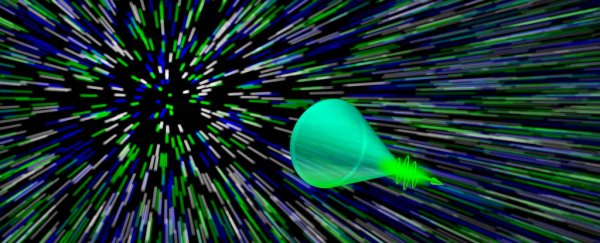For the first time, researchers have filmed light creating a 'sonic boom' - officially known as a photonic Mach cone - using a new type of ultra-speed camera that can capture an incredible trillion frames per second in just one take.
A Mach cone is created when something travels faster than the waves it's emitting - this often happens when a plane is travelling faster than the speed of sound, producing an ultra-loud boom. But not many people know light can do the same.
So how exactly do you create a 'photonic boom'? At first thought, it seems ludicrous that light could also have a Mach cone. After all, nothing can travel faster than the speed of light in a vacuum – about 300,000 kilometres per second.
But light can be slowed down, and as such it can slip faster though some material than others. Which is how the team were able to create the photonic Mach cone.
In this experiment, a team of researchers led by optical engineer Jinyang Liang from Washington University created a channel between two plates of silicone rubber and powdered aluminium oxide. They filled the gap with a dry-ice fog, and then fired a 7 picosecond laser pulse which scattered off the suspended particles.
Given the light passed more slowly through the walls of the tunnel than the fog, it created the photonic Mach cone you can see below:
 Jinyang Liang and Lihong V. Wang
Jinyang Liang and Lihong V. Wang
While other techniques have been used to capture these light cones, this is the first time a single instance of one has been filmed in real time, and in order to do it, the researchers had to create a whole new type of ultrafast camera.
High speed video isn't all that new. In 2011, Massachusetts Institute of Technology developed a camera that could capture a pulse of light making its way through a plastic bottle.
They used technology called a 'streak camera', which sweeps out an image in such a way that it converts the sequence into spatial information. The team filmed 500 images taken a trillionth of a second apart, showing light scatter as it passed lengthways through the bottle.
For the process to work, however, the scene has to be imaged over and over again to build up enough data. This isn't exactly useful for capturing events which don't conveniently repeat.
Instead, Liang and his team found a way to do away with multiple takes. Still using a streak camera they captured three views of the same event. One view captured a sequence of images, the remaining two recorded the timing of each shot. This way they could effectively tag each image, keeping them in order.
To test it out, they filmed the 'photonic boom' for the first time.
The real benefits to such technology, however, could be found in medicine.
"Our camera is fast enough to watch neurons fire and image live traffic in the brain," Liang explained to Live Science.
"We hope we can use our system to study neural networks to understand how the brain works."
The research has been published in Science Advances.
